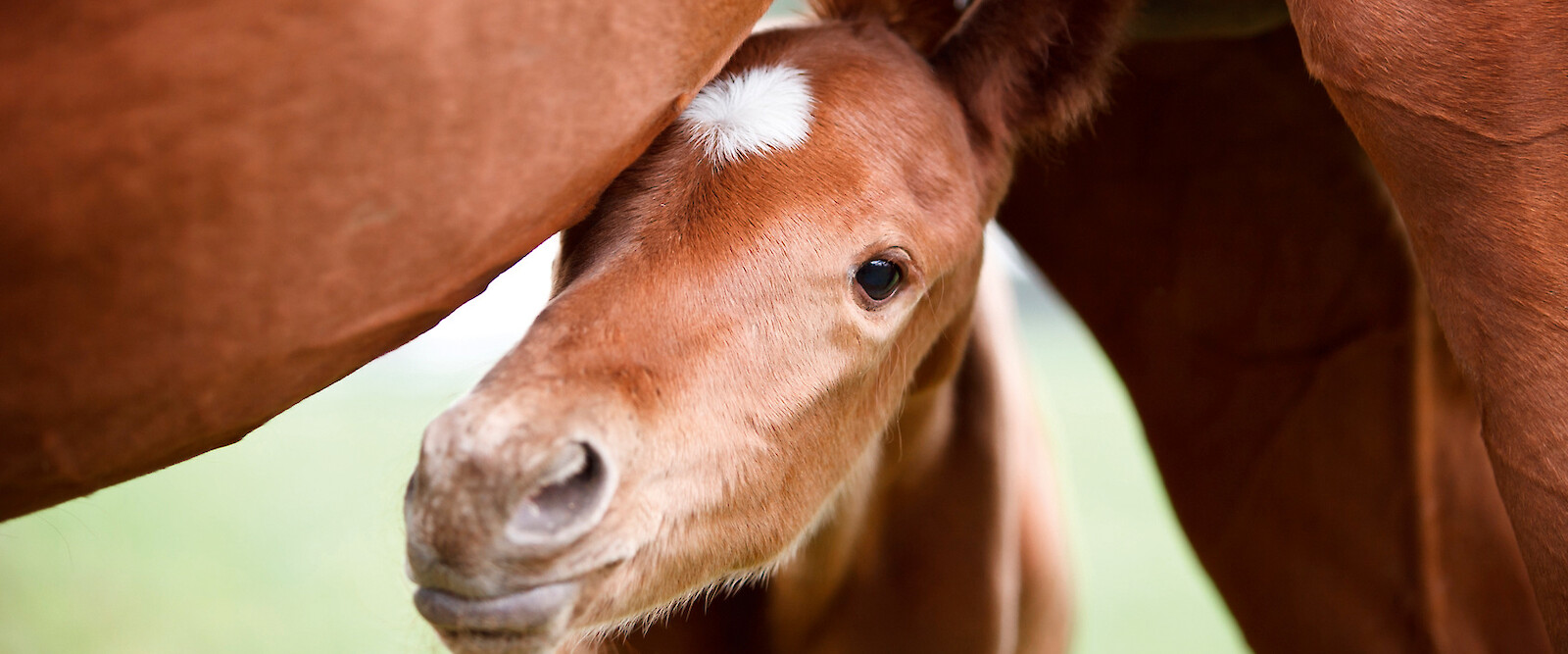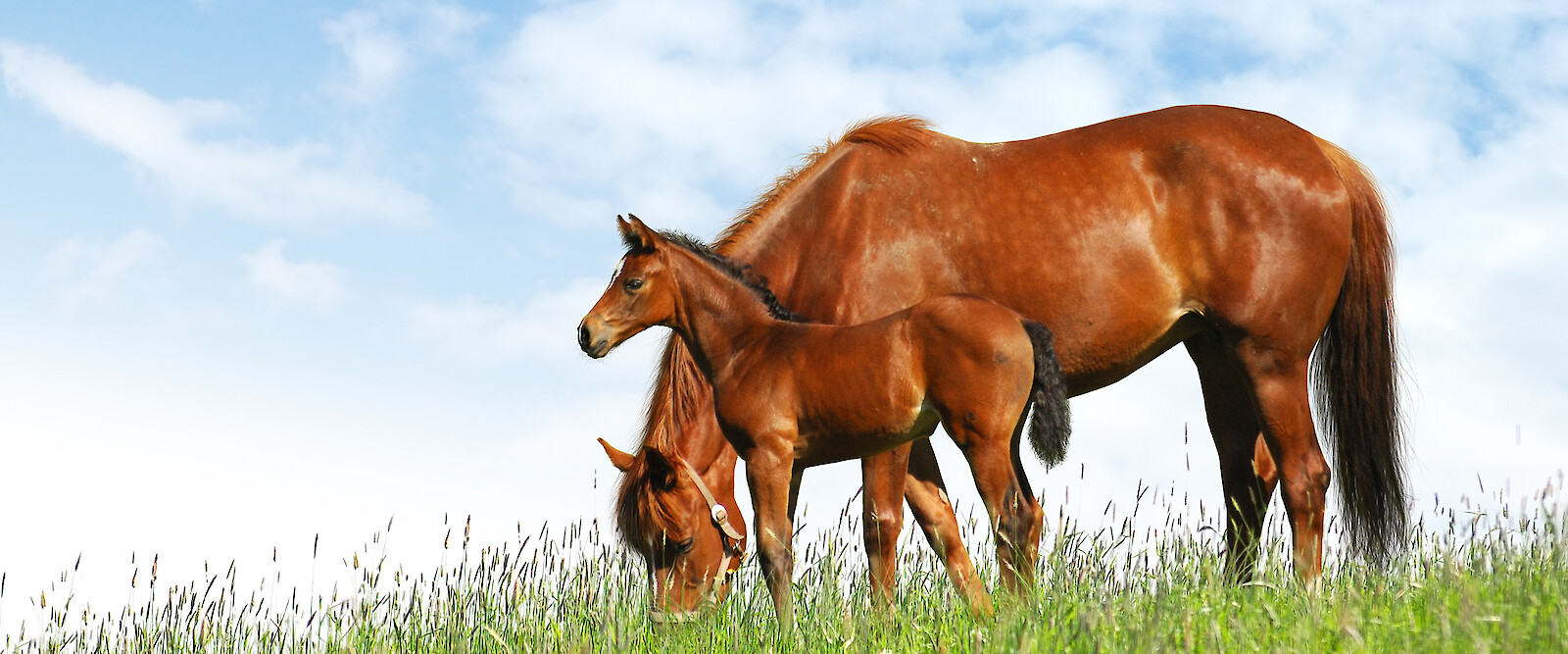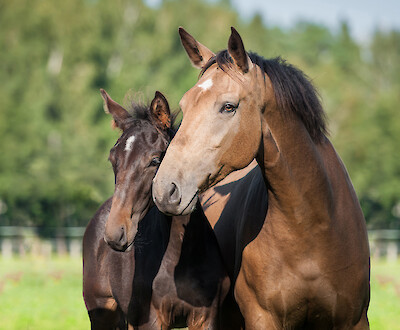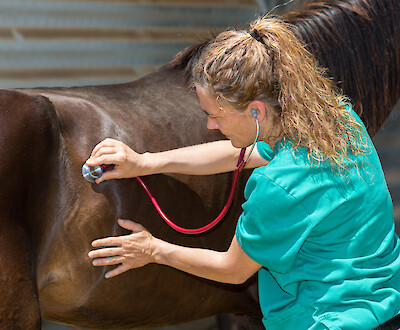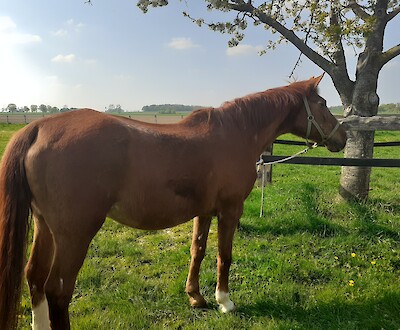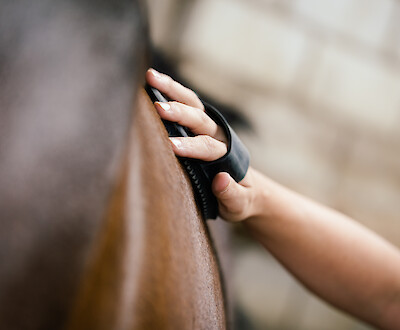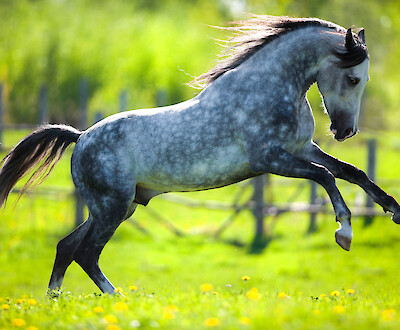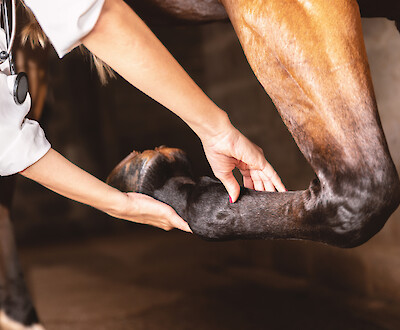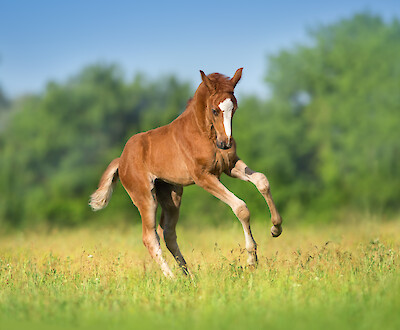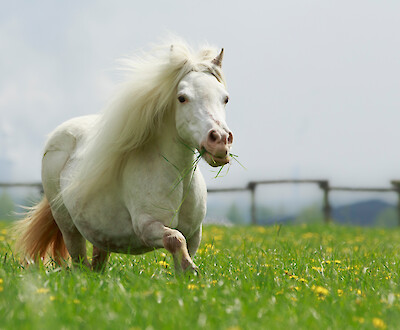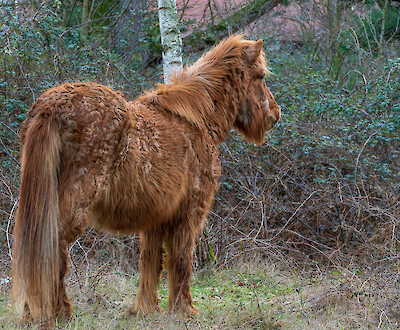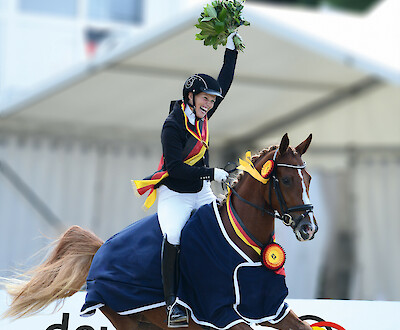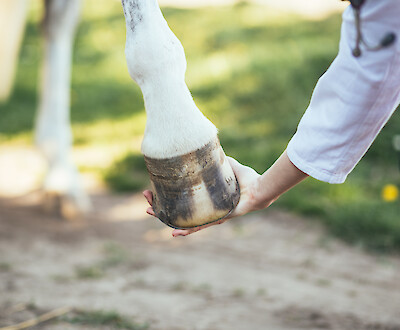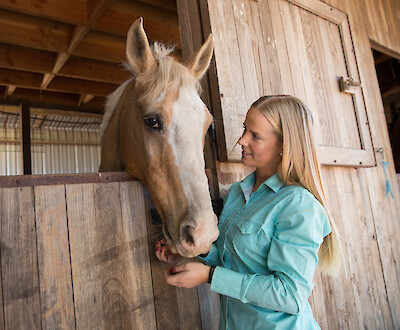Influence of feeding on mare and foal in pregnancy
Feeding pregnant mares: How to supply your horse in breeding according to its needs
Pregnant mares have special feeding requirements. The aim of breeding nutrition is not only to provide the mare with the vitamins, minerals and trace elements she needs. The growing foal must also receive everything it needs for its development through its mother's feed. To ensure that foaling goes off without complications, horse owners should also make sure that the mare is in good condition: Because even after birth, the mare needs reserves to produce enough colostrum or breast milk. In the following article you will learn how to ensure a safe supply of the mare and foal during and after pregnancy.
The average gestation period of horses is 320 to 360 days - however, fluctuations of up to three weeks are not unusual. There are two phases of pregnancy: the so-called low pregnancy (1st to 7th month) and the high pregnancy (8th to 11th month or until birth). In these two phases, the development of the growing foal proceeds differently and with it the needs of the mare and the unborn foal in terms of energy and nutrient supply.
Mare feeding during the period of gestation
The mare's requirements hardly change during the first months. It corresponds as far as possible to the maintenance requirement. Regular grazing, high-quality hay and mineral feed are usually sufficient for the mare's needs during the first months of pregnancy. However, depending on the breed and weight of the pregnant mare, small amounts of concentrated feed may already be necessary to ensure the supply of mother and foal. To ensure the basic supply of all important vitamins and minerals, precisely coordinated basic feeds such as deukavallo Top E are suitable.
Nevertheless, horse owners should pay attention to a balanced ratio of calcium (Ca) and phosphorus (P) in the total ration during gestation. The mare's daily requirement for calcium is about 27 g/day and for phosphorus about 15 g/day. But also the supply of the foetus with sufficient vitamin E and selenium must be ensured with the daily feeding. Otherwise there is a risk of cartilage weakness or porous bones in the growing foal. Vitamin E should be provided with approx. 100 mg per 100 kg body weight of the mare. The prospective horse mother needs approx. 10 mg/day of selenium.
Ensuring the care of mare and foal during peak pregnancy
Gestation is characterised by rapid development of the foetus. Almost 80 % of the total growth occurs in this phase. The growing foal fully develops all vital bodily functions during this phase. This results in special requirements for the feeding of the pregnant mare.
Changed basic feed intake requires concentrated feed
Due to the foal's enormous body growth, the space in the mare's abdominal cavity shrinks. This sometimes affects the intake capacity of hay, haylage and straw. In order to ensure the supply of both mare and foal, you should therefore gradually feed more concentrated feed from the eighth month of pregnancy onwards. At the same time, the expectant horse mother's demands on feed quality increase. Check the quality of the feed thoroughly again and make sure that all are free of mycotoxins, dust and vermin.
Energy and protein requirements increase dramatically during peak pregnancy
The mare's energy requirements increase by 25 to 40 % in the last three months of pregnancy. Horse owners must therefore begin to supply more energy through the feed from the 8th month of pregnancy. For this purpose, the ration should contain sufficient carbohydrates, ideally in broken down form (rolled oats, flaked barley/corn/wheat or hydrothermally broken down).
The protein requirement also continues to increase as pregnancy progresses. Therefore, gradually increase the amount of protein in the feed in order to feed 50 % more protein in the eleventh month than during low pregnancy. Only in this way will you enable the smooth development of the foals into vital foals.
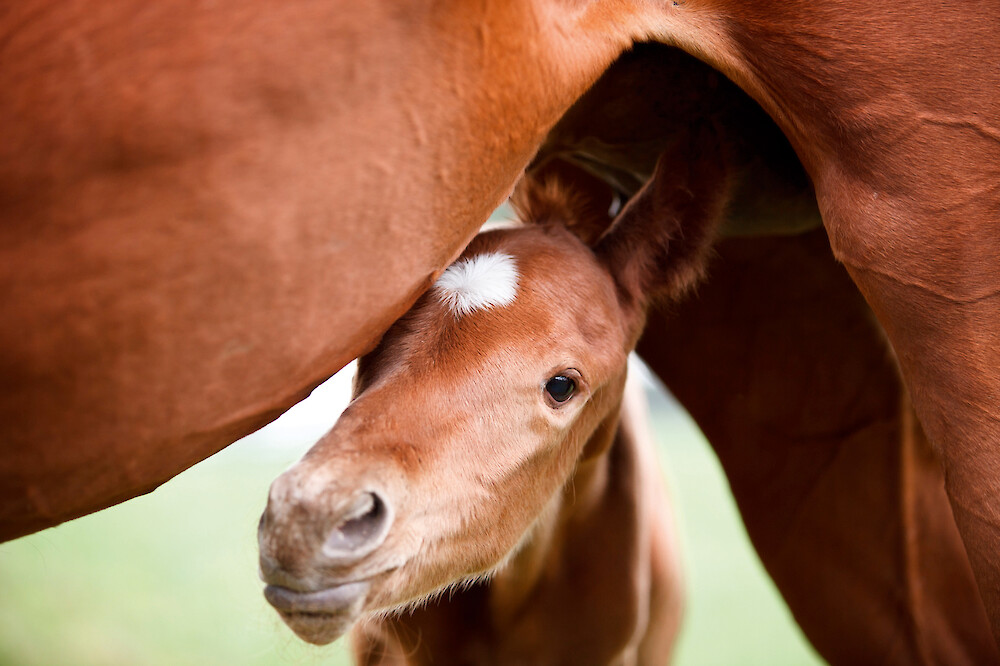
You must pay attention to these ingredients in the feed:
-
Due to the strong bone, ligament and cartilage growth of the foal in the womb, the ratio of calcium (Ca) and phosphorus (P) tips - at least if horse owners do not counteract this with an adjustment of the feed. For a custom-fit support, the Ca:P ratio of the total ration should be adapted to the mare's needs in the respective month of gestation. In principle, you should pay attention to a balanced Ca:P ratio of 2 to 1.
-
Vitamin E plays a central role in the development of the growing foal. It is involved in the formation of a healthy metabolism and physical development, above all the musculature. If these are well developed, the foal can stand and walk faster after birth, which promotes faster absorption of the vital colostrum. A vitamin E deficiency, on the other hand, can lead to early embryonic death and abortion as well as cause conditions such as white muscle disease.
-
But the mare also needs vitamin E. Thus, a sufficient supply promotes the smooth course of birth and improves uterine contraction. This is important for expelling the afterbirth. A sufficient intake with the feed also increases the vitamin E content in the mother's milk, which contributes to an excellent development of the foal.
-
Fat-soluble vitamin A, vitamin D, and vitamin K as well as ß-carotene must be present in sufficient quantities in the breeding feed. Together they are important for optimal embryonic development and later milk production. It is recommended to use vegetable oil supplements, as the fat-soluble vitamins are better absorbed by the horses' organism this way. Moreover, oils provide additional energy, which is needed by the mare especially in this phase.
-
-
Breeding feed for mares during pregnancy
Breeding feeds have been specially developed to supply mares during peak pregnancy and foals after birth. The protein-rich concentrates (e.g. deukavallo Zuchtmüsli) stimulate the formation of colostrum and thus enable the production of up to 25 litres of milk per day during the first month of lactation. By providing high-quality nutrients, breeding feeds also make a valuable contribution to the formation of an optimal condition of the mares. The high palatability and ideal mineralisation favour an early feed intake and good physical development of the foals. This gives your foal the perfect start in life. But also the high protein and energy requirements of stallions can be easily met with breeding feeds such as deukavallo Zuchtmüsli. You can find specific feeding recommendations here in the tab "How to feed".
Mineral feed keeps the calcium-phosphorus ratio in balance
Feeding cot feed affects the Ca:P ratio and can shift it. To balance the ratio, feeding a mineral feed (e.g. deukavallo Mineral) can be useful. Discuss the adjustment of the feed with your country dealer or the responsible field representative.
Pasture walks and regular exercise: good for mare and foal
Sufficient exercise is important for the mare's health in all phases of pregnancy. Grazing and regular walks promote the mare's metabolism and maintain her muscles during pregnancy. The more vital and fit the mare is, the smoother the birth usually goes. - Sufficient exercise is also crucial for the development of the newborn foal. Only sufficient activity increases the pulse rate of the newborn, which it needs to store sufficient calcium in the bones.
The importance of exercise for the health of mare and foal is reflected in the recommendation among horse owners: It is better to refrain from an early birth date if sufficient exercise cannot be ensured through rides and grazing after birth. Horse owners should schedule the occupancy of mares in such a way that mare and freshly born foal can go directly to pasture.
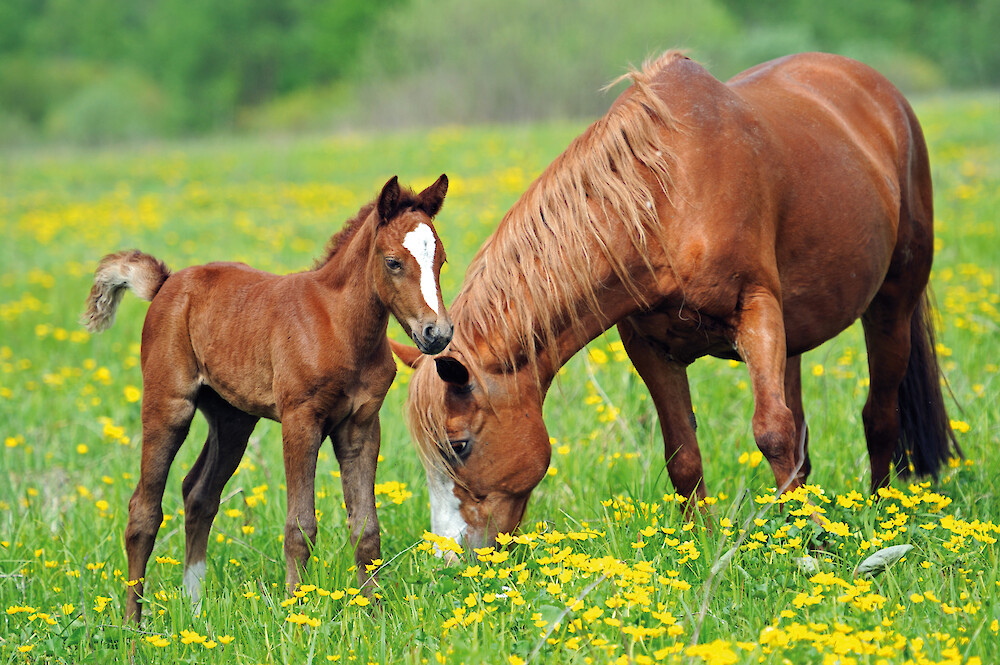
Smooth birth due to good condition of the mare?
The fatter the mare, the more difficult the birth. Being overweight can increase the risk of complications during foaling. Lean mares, on the other hand, cannot provide their foals with all the nutrients necessary for their development already in the womb. Foals of lean mares are therefore usually light and often underdeveloped. During lactation, underweight mares continue to lose weight. This makes rebreeding in the same year of birth almost impossible. Therefore, make sure your broodmare is in good condition before birth.
Make sure you have a sufficient supply of fluids
Make sure you have enough fresh water, during and after birth. Water must always be freely available. If the mare drinks too little, this can result in a milk deficiency. You must also always keep an eye on the foal's water requirements. Because:
- If the foal does not drink enough, this may indicate that it is not fit. If the foal does not take the available milk from the mare, the milk yield will decrease. In this case, have the foal examined and milk the mother. This will maintain the milk yield.
- If the foal is suckling too often and too much, the mare may not be producing enough milk. In this case, consider adding a milk replacer. Failure to act quickly in this situation may result in an undersupply of the foal.
Health tip: Deworming the mare before birth
As part of the veterinary examination of the mare before birth, you should discuss deworming. If there is a worm infestation, this can also have health consequences for the foal. The larvae of the dwarf threadworm (lat. Strongyloides westeri) can be transmitted to the newborn via the colostrum and infect it.
The mare's own nutrient intake and digestion can also suffer. Proper deworming is usually done six to eight weeks before the calculated due date and again immediately before birth.
Checklist: Prepare the birth of the foal properly
-
- Prepare the foaling box several weeks before the birth. This should be large enough (approx. 14 to 20m2). Clean the box thoroughly before moving in and give it a fresh litter.
- If necessary, lay out a large, non-slip mat to provide the mare with secure footing during the birth.
- Remove the salt lick from the box or place it out of the foal's reach. Early salt intake leads to diarrhoea in foals!
- Especially in autumn and winter: Install a heat lamp and provide thick blankets.
-
- Keep a close eye on the mare shortly before birth so as not to miss the start of the birth (use cameras or special birth control systems if necessary).
- Write down the telephone number of the vet (landline AND mobile phone) and keep it handy at all times.
-
- Set up a small stable pharmacy. Contents (selection): Disinfectant spray, iodine solution, washing lotion, fever thermometer, baby bottles, foal milk, clamp for the umbilical cord, respiratory stimulating medication (e.g. based on the active ingredients cropropamide and/or crotethamide).
- Prepare several large, clean towels and rubber gloves.
- Sufficient fresh, lukewarm water and a drinking bucket.
- Provide a bucket and rope to hang up the afterbirth.
-
- Chill a bottle of sparkling wine (or schnapps!). Don't forget glasses for toasting.
Conclusion
- Mares make special demands on daily feeding during pregnancy.
- The mare's requirement in low pregnancy hardly differs from the maintenance requirement. However, pay attention to a balanced ratio of calcium and phosphorus.
- During peak pregnancy, the need for energy (carbohydrates) and protein increases dramatically. The need for important vitamins (e.g. vitamin E) and nutrients (e.g. selenium) also increases.
- Special breeding feeds such as deukavallo Zuchtmüsli cover the higher requirements of mare and foal well.
- Make sure that the mare and foal get enough exercise, provide sufficient drinking water and deworm the mare before birth.
Further information on feeding during pregnancy and breeding
- Checklist "Stall birth - The most important information about birth at home..."by the equine clinic Bieberstein.
- The Soil Atlas of the Federal Institute for Geosciences and Natural Resources (BGR) shows the selenium content of soils in Germany.
- Specialised information for horses in Futtermittel.net of the German Agricultural Society (DLG).
Image sources (top slider): © Kseniya Abramova - stock.adobe.com / © Shelley Paulson - stock.adobe.com / © kyslynskyy - stock.adobe.com
Contact person

Theresa Oesterwind
Contact person

